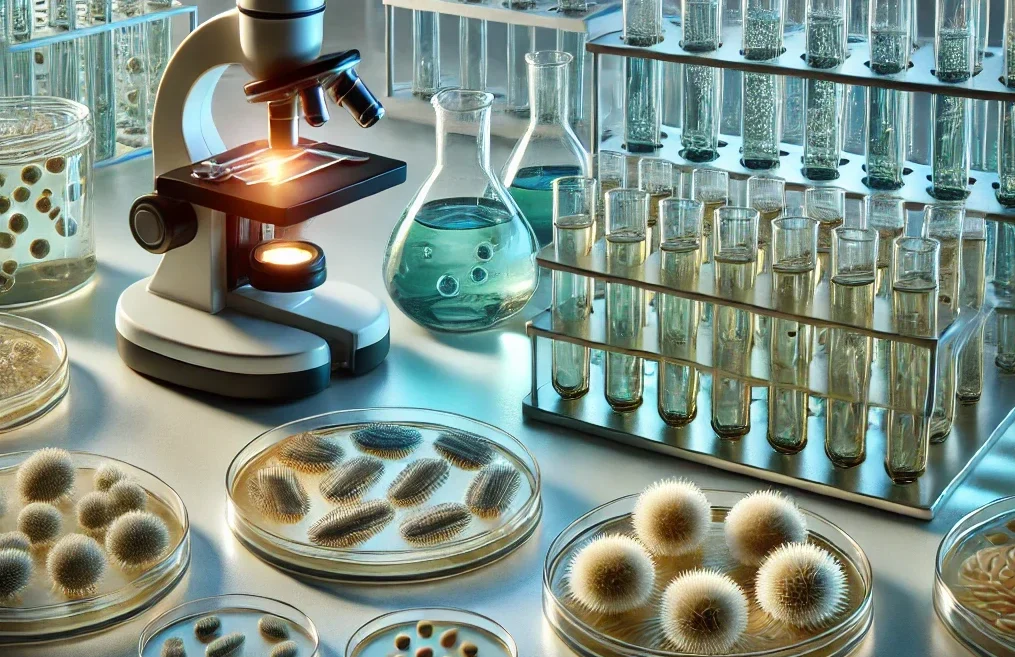Bacteriostatic and Bactericidal Actions refer to how antimicrobials work: bacteriostatic inhibits bacterial growth, while bactericidal kills bacteria directly.
Bacteriostatic vs. Bactericidal Actions
-
Bacteriostatic Action:
- Inhibits the growth and reproduction of bacteria without killing them.
- If the bacteriostatic agent is removed, bacteria can resume growth.
-
Bactericidal Action:
- Kills bacteria directly, reducing the bacterial count.
Evaluation Methods for Bacteriostatic and Bactericidal Actions
1. Tube Dilution Method
-
Purpose:
- To determine the Minimum Inhibitory Concentration (MIC) and Minimum Bactericidal Concentration (MBC) of an antimicrobial agent.
-
Procedure:
- Preparation of Dilutions: Prepare serial dilutions of the antimicrobial agent in a liquid growth medium.
- Inoculation: Inoculate each tube with a standardized number of the test organism.
- Incubation: Incubate the tubes under suitable conditions for the organism.
-
MIC Determination:
- After incubation, observe the tubes for visible growth.
- The MIC is the lowest concentration of the antimicrobial agent that inhibits visible growth.
-
MBC Determination:
- From the tubes showing no visible growth, subculture aliquots onto fresh agar plates without the antimicrobial agent.
- Incubate the plates.
- The MBC is the lowest concentration that shows no growth on the agar plates.
-
Interpretation:
- MIC indicates bacteriostatic activity (inhibition of growth).
- MBC indicates bactericidal activity (killing of bacteria).
2. Agar Plate Method (Disk-Diffusion and E-test)
-
Disk-Diffusion Method:
- Inoculation: Spread a standardized inoculum of the test organism on the surface of an agar plate.
- Application of Disks: Place paper disks impregnated with the antimicrobial agent on the agar surface.
- Incubation: Incubate the plate under suitable conditions.
- Observation: Measure the diameter of the zone of inhibition around each disk.
-
E-test:
- Inoculation: Spread a standardized inoculum of the test organism on the surface of an agar plate.
- Application of Strips: Place an E-test strip with a gradient of the antimicrobial agent on the agar surface.
- Incubation: Incubate the plate under suitable conditions.
-
Observation:
- Read the MIC value at the point where the zone of inhibition intersects the strip.
-
Interpretation:
- The size of the inhibition zone (disk-diffusion) or the MIC value (E-test) indicates the antimicrobial activity.
3. Cup-Plate Method
-
Purpose:
- To evaluate the antimicrobial activity by measuring the inhibition zone.
-
Procedure:
- Preparation: Pour a layer of agar medium into a Petri dish and allow it to solidify. Punch wells (cups) into the agar.
- Inoculation: Add a standardized inoculum of the test organism to the agar surface.
- Addition of Antimicrobial Agent: Fill the wells with the antimicrobial agent.
- Incubation: Incubate the plate under suitable conditions.
-
Observation:
- Measure the diameter of the zone of inhibition around each well.
-
Interpretation:
- The size of the inhibition zone correlates with the antimicrobial activity.
4. Phenol Coefficient Method
-
Purpose:
- To compare the efficacy of a test disinfectant with that of phenol.
-
Procedure:
- Preparation: Prepare serial dilutions of the test disinfectant and phenol.
- Inoculation: Inoculate each dilution with a standardized number of the test organism.
- Contact Time: Allow a fixed contact time (e.g., 5 and 10 minutes).
- Neutralization and Subculture: Neutralize the disinfectant action by subculturing aliquots into a fresh growth medium.
-
Observation:
- Observe and record the highest dilution that kills the organism in 10 minutes but not in 5 minutes.
-
Calculation:
- Calculate the phenol coefficient as the ratio of the highest effective dilution of the test disinfectant to that of phenol.
-
Interpretation:
- A phenol coefficient greater than 1 indicates that the test disinfectant is more effective than phenol.
5. Kelsey-Sykes Test
-
Purpose:
- To evaluate the efficacy of disinfectants under simulated practical conditions.
-
Procedure:
- Preparation: Mix the test disinfectant with a suspension of the test organism.
- Contact Time: Allow the mixture to stand for a specific contact time (e.g., 8 minutes).
- Neutralization: At intervals, withdraw samples and add to a neutralizing medium.
- Subculture: Subculture the neutralized samples into a fresh growth medium.
- Incubation: Incubate the cultures.
-
Observation:
- Observe for growth to determine the bactericidal action.
-
Interpretation:
- The absence of growth indicates bactericidal activity, while the presence of growth indicates bacteriostatic activity or resistance.
Factors Affecting Evaluation
- Inoculum Size: Larger bacterial populations may require higher antimicrobial concentrations.
- pH and Temperature: Can influence antimicrobial efficacy.
- Presence of Biofilms: Bacteria in biofilms are more resistant, affecting test outcomes.
- Medium Composition: Nutrient availability and ions can impact bacterial susceptibility
Click Here to Watch the Best Pharma Videos

